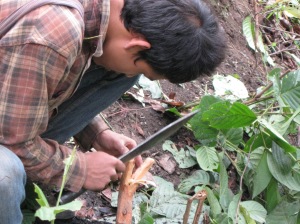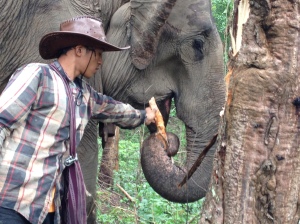On the daily hikes I find myself watching the mahouts almost as much as I watch the elephants. A mahout is part elephant trainer, part elephant companion, part master outdoorsman. They lead the hikes and are at least partially responsible for the volunteers’ health and welfare.
The mahouts are also the face of the people of the village, the people we volunteers see and communicate with—well, as much as we can communicate with them—every day.
The mahouts don’t carry backpacks and they don’t wear hiking boots (Many wear only wear flip flops). They don’t apply sunscreen or bug repellent. They don’t ever have to stop to rest (unlike us wheezing volunteers, who dictate the pace of the hikes). I never once saw a mahout drink water, though I imagine they must have snuck a few swigs at some point. That is, unless they are part camel.
The mahouts shun most tools: so no flashlight, compass, or knife. But they all have machetes, and I rarely see a mahout who lets his machete rest in its sheath for very long.
There’s always brush to chop to clear a path, bamboo leaves to rip off for the elephants, bamboo stalks to whittle down to craft into cooking utensils. There are also slingshots to carve, leeches to slay, and even some jaunty machete-on-tree drumming to pass the time.
Patti Sai-Ee is the eldest mahout by far at 55. No other mahout is even close to his age. He wears canvas Keds–black–and a baseball cap—also black. The two caps I see in his repertoire have ‘Police’ and ‘Epson’ printed in bold letters across them. I doubt he has a printer, though I can picture him watching an episode of ‘Cops’.
His fingers have an arthritic-looking gnarl to them, though I never see that he has any difficulty using them. In fact Patty Sai-Ee, like all of the mahouts, is constantly busy with his hands—whether wielding the machete or smashing his hands together on a ‘popper’ plant—that pops like a firecracker when struck just so. I like the fact that a 55-year-old man still likes to make loud noises, especially among a herd of elephants.
Patti Sai-Ee talks haltingly if at all, in a low voice, mostly to the other mahouts. They are so much younger than him that I wonder if this makes him a bit isolated, if he’s an outsider in his own village and in his own dwindling professional circle. Mahouts are already marginalized in Thailand, and what used to be an honorable profession is becoming somewhat of a lost art. These days it is generally regarded as dirty, lowly. More money can be made as a beggar than as a mahout.
Patty Sai-Ee is the mahout of Tong Dee. She is around his age, and Tong Dee is like the elephant version of him: quiet, calm, stoic. But unlike her mahout, Tong Dee can be ornery. She will not obey the other mahouts, and they are open about their fear of her.
They approach Tong Dee only in the presence of Patty Sai-Ee.
 The lead mahout is Singto, at only nineteen. He’s the mahout for Kam Suk, the oldest elephant of the herd, who is in her late fifties. Singto is the only mahout who talks about an elephant’s emotional state: he points out when she’s happy (most of the time), or when she’s aggravated or scared (steering us safely away from her).
The lead mahout is Singto, at only nineteen. He’s the mahout for Kam Suk, the oldest elephant of the herd, who is in her late fifties. Singto is the only mahout who talks about an elephant’s emotional state: he points out when she’s happy (most of the time), or when she’s aggravated or scared (steering us safely away from her).
Singto is already married and he has a baby girl. He is the most outgoing mahout and speaks the best English. He also seems to defy gravity: he runs up and down mountains–in cheap canvas sneakers. Up is one thing. At nineteen, and considering his work, he should be in shape to do that. But running down them requires a balance, agility, and fearlessness that I just cannot fathom.
Singto seems to be everywhere at once. He is at the front leading the way one moment, at the rear helping a straggler the next. When I think of Singto I think of him with his hand out.
He loves to tease and joke. In a quiet moment in the middle of a strenuous hike he will sing out, “Mike, are you okayyy?” He drags out ‘okay’ in a concerned motherly tone.
I like when I can surprise him back: “Singto, are you okayyy?” It becomes a regular thing, back and forth between us, and one time he shocks me when he spreads his arms out, grinning, and proclaims, “I am fiiine!”
After one particularly grueling hike I am alone with him, walking back to the village. He puts his arm on my shoulder for a moment.
“I am tired… you tired?” Singto’s smile cracks open his entire face. I tell him I am and he says, “Good tired, yes? Good tired.”
“Yes,” I agree, smiling back at him. This is a man who loves his work.
With Singto and Patty Sai-Ee, I witness a connection between them and the elephants that goes beyond dominating a beast, beyond leading around a four ton meal ticket (and make no mistake, the mahouts see their elephants as their livelihoods first and foremost).
Singto will slice up tree bark with his machete and spoon feed it to Kam Suk. The gesture is as delicate and loving as I imagine it is with his own child.
Patti Sai-Ee rarely fraternizes with the other mahouts or the volunteers. He seems to genuinely prefer the company of his elephant. He will squat in front of Tong Dee, pick a blade of grass (hands always busy), and stare ahead into the distance. Patty Sai-Ee says he thinks of Tong Dee as his wife. As for Tong Dee, she may tower above this tiny man, but with a gesture or a few simple, quiet words from him, she will usually follow him anywhere.
Every Tuesday night at Base Hut is quiz night. The volunteers pair off into teams and compete to answer a barrage of trivia questions. One quiz night, one of the questions is actually more of a challenge: each team has thirty seconds to draw their best version of Patty Sai-Ee.
The girls on one team draw a picture of Yoda. They win, hands down.













I love this blog so much!!
Thank you so much!
Very interesting and I love the pictures! Thank you so much for sharing!
You’re welcome and thank you for visiting 🙂
This is so interesting to read. Such great insights, wonderful writing and photos!